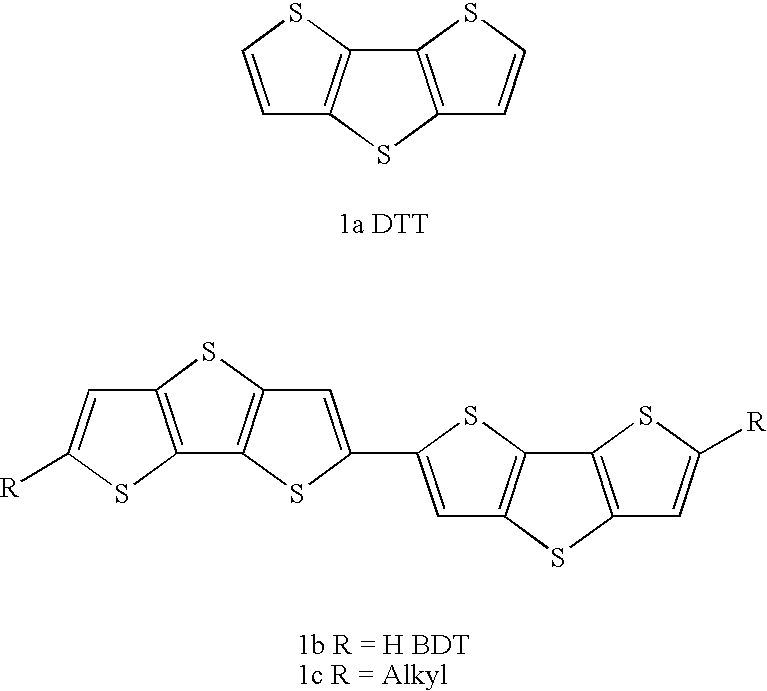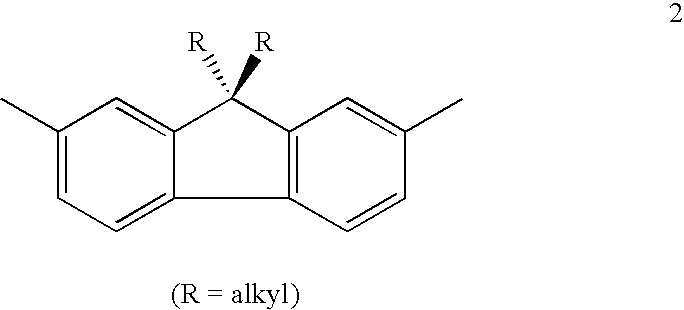Mono-, oligo- and polymers comprising fluorene and aryl groups
a polymer and fluorene technology, applied in the field of mono-oligo- and polymer polymers, can solve the problems of reducing device performance, inability to easily solve processing, and expensive processing techniques that are unsuitable for the fabrication of large-area films
- Summary
- Abstract
- Description
- Claims
- Application Information
AI Technical Summary
Problems solved by technology
Method used
Image
Examples
example 1
[0143]Poly(3,3′-dihexyl-2,2′-bithiophene-alt-fluorene) of formula I1a, wherein R1 is n-hexyl, was prepared according to Scheme 1.
[0144]2,7-Bis(4,4,5,5-tetramethyl-1,3,2-dioxaborolan-2-yl)-fluorene (8) 2,7-Dibromofluorene (5.74 g, 17.73 mmol), bis(pinacolato)diboron (11.26 g, 44.33 mmol), potassium acetate (5.22 g, 53.20 mmol) and dichlorobis(tricyclohexylphosphine)palladium(II) (0.78 g, 0.61 mmol) were charged in a 3-necked flask. Anhydrous 1,4-dioxane (150 mL) was added and the reaction mixture was stirred at 100° C. for 24 h. The reaction mixture was quenched with water (100 mL) and extracted into chloroform (2×200 mL). The combined extracts were washed with water (100 mL), dried over sodium sulfate and concentrated in vacuo. Purifcation by column chromatography (eluent: dichloromethane) yielded the product as a white solid (5.67 g, 13.56 mmol, 76%). NMR shows the expected signals. M+=418.
[0145]3,3′-Dihexyl-2,2′-bithiophene was prepared according to the method of P. Bäuerle, F. Pf...
example 2
[0150]30 Poly(4,4′-didodecyl-2,2′-bithiophene-a / t-fluorene) of formula I1b, wherein R1 is n-dodecyl, was prepared according to Scheme 1.
[0151]Poly(4,4′-didodecyl-2,2′-bithiophene-alt-fluorene) (6) (R═C12H25) A 3-necked flask was charged with 2,7-bis(4,4,5,5-tetramethyl-1,3,2-dioxaborolan-2-yl)-fluorene (8) (0.60 g, 1.44 mmol), 5,5′-dibromo-4,4′-didodecyl-2,2′-bithiophene (0.95 g, 1.44 mmol), tetrakis(triphenylphosphine)palladium(0) (34 mg, 0.03 mmol), Aliquat 336 (0.25 g) and toluene (20 mL) under nitrogen. A 2 M aqueous solution of sodium carbonate (2.5 mL) was added and the reaction mixture was stirred at reflux for 48 h. The reaction mixture was precipitated into methanol (400 mL). The polymer was collected and washed with water followed by methanol. After drying, the polymer was washed with methanol (via Soxhlet extraction) for 16 h followed by iso-hexane (via Soxhlet extraction) for 6 h. The polymer was then redissolved in hot chloroform and reprecipitated from methanol (400 mL...
example 3
[0152]Poly(9-((bishexyl-methylene)fluorene-alt-fluorene)) of formula If, wherein R1 is n-hexyl, was prepared according to Scheme 1.
Poly(9-((bishexyl-methylene)fluorene-alt-fluorene)
[0153]A 3-necked flask was charged with 2,7-bis(4,4,5,5-tetramethyl-1,3,2-dioxaborolan-2-yl)-fluorene (8) (0.622 g, 1.49 mmol), 2,7-dibromo-9-(bis-hexyl-methylene)fluorene (0.75 g, 1.49 mmol), tetrakis(triphenylphosphine)palladium(0) (17 mg, 0.015 mmol), Aliquat 336 (0.25 g) and toluene (20 mL) under nitrogen. A 2 M aqueous solution of sodium carbonate (2.5 mL) was added and the reaction mixture was stirred at reflux for 22 h. Bromobenzene (0.12 g, 0.75 mmol) was added and the solution was stirred for 1 h at reflux, then bezene boronic acid was added and the solution stirred for a further 1 h at reflux. The reaction mixture was cooled, precipitated into methanol (400 mL). The polymer was collected and washed with water followed by methanol. After drying, the polymer was washed with methanol (via Soxhlet e...
PUM
| Property | Measurement | Unit |
|---|---|---|
| temperature | aaaaa | aaaaa |
| temperature | aaaaa | aaaaa |
| Tg | aaaaa | aaaaa |
Abstract
Description
Claims
Application Information
 Login to View More
Login to View More - R&D
- Intellectual Property
- Life Sciences
- Materials
- Tech Scout
- Unparalleled Data Quality
- Higher Quality Content
- 60% Fewer Hallucinations
Browse by: Latest US Patents, China's latest patents, Technical Efficacy Thesaurus, Application Domain, Technology Topic, Popular Technical Reports.
© 2025 PatSnap. All rights reserved.Legal|Privacy policy|Modern Slavery Act Transparency Statement|Sitemap|About US| Contact US: help@patsnap.com



